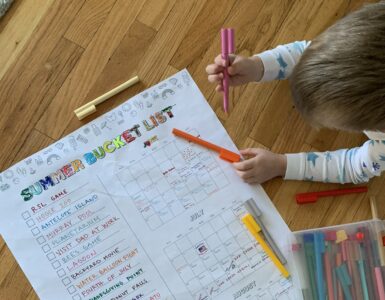Kelly Pratt shares her solution to this age old problem.
If you want this year’s shopping adventures to be manageable and fun and you’d also like to save time, energy and money, try this three-step solution.
Step 1: Plan
CREATE AN INVENTORY
Before you step foot inside a store, remember that you will save time, energy and money if you know what you’re there for. And you can’t know what you need until you know what you already have. Create an inventory by spending 20 to 30 minutes with each child determining what he or she can still use from last year. As you inventory current items, you can create the following categories:
Keep. In this category are items your child can still use and/or wear and items that you can hand down to younger siblings. You can move a few worn items into your emergency prep kit or save them for camping. You may also wish to create “To Grow Into” and “Off-Season” containers for clothing and shoes you want to save for future use.
Swap. Arrange to swap clothing with neighbors, friends or family members.
Donate. Choose the donation option that best suits you. There are several centers and associations to whom you can donate both used and new articles of clothing and accessories. Here’s a list to get you started:
(1) Deseret Industries.
(2) Good Will.
(3) Children’s shelters.
(4) Homeless shelters.
(5) Big Brothers, Big Sisters.
(6) Drug rehabilitation centers.
(7) Children’s hospitals.
(8) YWCA.
(9) Neighbors.
(10) Friends.
Sell. If you’d like to generate some cash from your unused items, you might launch a yard sale, sell your items online or take them to a consignment store.
CREATE A PURCHASE LIST
Now that you know exactly what you have, you can make a list of what you need. To simplify the process, create your lists by child. Make sure to include—
• Clothing.
• Undergarments.
• Shoes.
• Backpacks.
• Lunch boxes.
• Supplies. (Visit http://www2.scholastic.com/browse/article.jsp?id=1308 for a good list of school and craft supplies.)
DETERMINE YOUR BUDGET
After deciding what you need to purchase, it’s time to determine your budget. You may want to involve your child in the budgeting so you can discuss which items are budgeted “must haves” and who is paying for what, if applicable. To help with budgeting, you can create a spreadsheet to track your expenditures. You may also wish to determine which purchases will be made online so you can check their prices before heading to the store and scour weekly ads for the best deals.
SAVE YOUR SANITY
Two final pieces of sanity-saving advice:
• Map your shopping excursion geographically. If you have created your master list in Excel, you can sort by your “Store” or “Where to Buy” column, and all items from the same stores will be grouped together. If your master list is in a hand-written format, take some time to go through the list to group items together by store or to highlight each store by color. Map your stops by proximity of stores to each other so you can save time.
• Try to shop with the fewest children possible, particularly when shopping for clothing items. You will save time, energy, stress and money if you don’t have to wrangle 4 children into a dressing room!
Step 2: Shop
Shopping day is about minimizing effort and maximizing results. To get the most benefit for your time, energy and money, keep these guidelines in mind.
Get a sitter. If you’ve ever tried to marathon shop with several children, this point needs no explanation. Whether you opt to swap sitting with a friend, hire a high-schooler, leave the kids you’re not shopping for with your spouse or relatives or use a drop-in center, you and your little shopper will have much more fun if you don’t have to manage meltdowns (including your own).
Shop during “off” hours if possible. Early morning and late evening can be less crowded than daytime hours. Decide whether this makes a difference to you, and plan your schedule accordingly.
Answer only more urgent cell phone calls, and don’t stop to text. You are likely to forget things and will take longer to find what you’re looking for if you are distracted by talking or texting.
Stick to the plan! “I’m going to the store for milk.” How often have we said THAT and come home with $50.00 worth of groceries? Sales are tempting. Do your best not to rationalize expenditures not on your list.
Update your spreadsheet as you shop to keep in mind how much you’re spending. Update your file when you get home so you have an accurate record for next year.
Keep receipts together. Create a receipt container for each child and put all his or her receipts in that container. You can use a mesh or leather pouch, coupon holder, envelope or even a plastic baggie. Containing your receipts will make returns a snap.
Carry a notebook and have an extra pen or two in your purse. Make note of—
o Additional items you forgot in your initial plan.
o Items you may wish to consider for gift-giving opportunities.
Step 3: Put Away
The final step of your school shopping extravaganza is to get everything put away. Take everything out of bags and boxes and get them into drawers and closets so you won’t forget what you have. You can also separate bulk items into what you will use right away and what you will store for future use.
Best wishes for a great school year, and happy organizing!
Kelly
you can get more information at www.spaceslimitedorganizing.com















Add comment